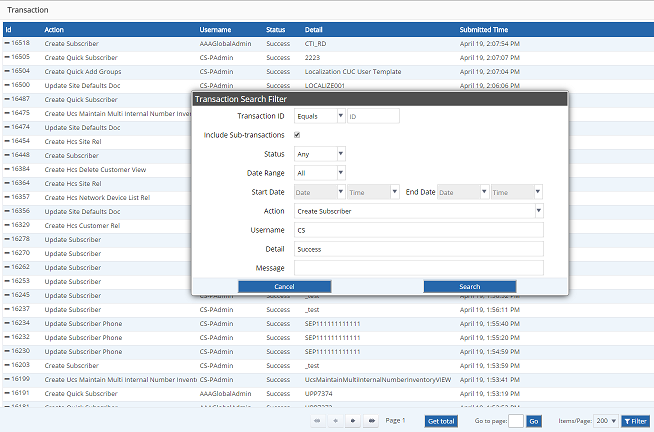Filtering Transactions¶
Choose Administration Menu > Transaction to open the list of
parent ( ) transactions.
When a parent transaction is selected and opened from the list view,
its details and sub-transactions are shown.
) transactions.
When a parent transaction is selected and opened from the list view,
its details and sub-transactions are shown.
To open the Transaction Search Filter pop-up, use either:
- the Filter button at the bottom of the list
- one of the filter icons in a column header of the list

A transaction filter is a logical AND operation over a number of active search criteria related to column values that are entered in the Transaction Search Filter pop-up form:
Transaction ID:
- Equal: Default setting. The search only matches on the entered transaction or sub-transaction ID value.
- If a value is entered, all other criteria are disabled.
- If no value is entered, any transaction ID is matched according the other criteria.
- Range: Start and End ID input boxes are available to specify the search ID range.
Include Sub-transactions:
- Criteria in the search filter also apply to sub-transactions. Only one level of sub-transactions are filtered, in other words, if sub-sub-transactions are for example present, these are not included.
- The search result list view shows both parent (
 ) and
sub-transactions (
) and
sub-transactions ( ).
). - By default, sub-transactions of a parent are listed above the parent in the search result list view, latest date at the top.
Status:
- A drop-down is available to select the transaction status
Date Range: a drop-down is available so that the last day, week or month can be selected quickly.
Note that if a date range: Last Day, Last Week or Last Month is selected, the subsequent re-opening of this filter will show it as a Custom date range, since the range is then less than the selected interval.
All and Custom date options will enable Start Date and End Date controls.
Start Date and End Date and Time: specify a transaction date and time range in the format of the system locale. For example, for language code
en-us, the typed format ismm/dd/yyyy. The number format “9” instead of “09” is also valid.Date picker widgets and time drop-downs can be used to specify the range, but values can also be typed in. While time drop-down values only show 15 minute intervals, any valid minute value can be typed in. The widget values also follow the system locale format.
- If a Username, Detail or Message filter is added, a warning about possible slow filtering will show if the transaction date range is more than 7 days.
- By default, all transaction dates are searched, but if used, both Start Date and End Date values are required.
Action: a drop-down to select a value from the Action column.
- The drop-down options are filtered while text is entered.
- If text is entered that does not match any action exactly, all actions containing the text (case-insensitive), will be listed.
- If the transaction date range is more than 7 days, a warning about possible slow filtering will show.
Username: filter on the Username column text.
- The column should contain the entered text, case-insensitive.
- If the transaction date range is more than 7 days, a warning about possible slow filtering will show.
Detail: filter on the Detail column text.
- The column should contain the entered text, case-insensitive.
- If the transaction date range is more than 7 days, a warning about possible slow filtering will show.
Message: filter on the transaction message
- The message contains the entered text, case-insensitive
- If the transaction date range is more than 7 days, a warning about possible slow filtering will show.
- For failed transactions, hover over the Status column to see the message or inspect it in the detail view.
- Some successful transactions also show messages when viewing its details, for example data import and bulk load.
Since transaction filters can take a long time, a filter timeout is added to limit the filter duration to 2 minutes.
Active transaction, sub-transaction and transaction log filters are displayed:
- at the bottom of the list view, as an X button next to the active Filter funnel icon. Select this X button to cancel a running filter. If the filter is a modification of a previous successful filter, the running filter will be reverted to the successful filter.
- in the columns headers that have been filtered, as highlighted funnel icons on the right hand side of the column header.
